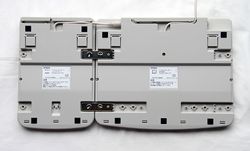Epson Business Full Keyboard
 | |
| Part number | BFKBPS2 or IKXFKB |
|---|---|
| Branding | Topre, Epson |
| Manufacturer | Topre |
| Layouts | 82-key JIS (130-key with Business Ten Keyboard) |
| Keyswitches | Topre Switches |
| Interface | PS/2 (USB for Business Ten Keyboard) |
| Weight | ~2kg (including Business Ten Keyboard) |
| Years of production |
|
| Price | ~¥68,000 – 98,000 |
The Epson Business Full Keyboard (ビジネスフルキーボード) is a full size Japanese keyboard made by Topre for Epson. It includes the 82-key JIS keyboard, and the 48-key Business Ten Keyboard (ビジネステンキーボード). The Business Full Keyboard was sold alone with the model number ‘BFKBPS2’ or as an option on the InterKX line of servers as the ‘IKXFKB’. The Business Ten Keyboard was also sold standalone with a USB interface from March 26th 2003. The rough timeline of releases is as follows:
- 2000 — InterKX IKXFKB (PS/2) for ¥98,000[1]
- 2003 — Business Ten Keyboard (USB) for ¥38,000[2][3]
- 2004 — Business Full Keyboard (PS/2) for ¥68,000[4][5]
Description
The Business Full Keyboard (henceforth referred to as ‘BFK’) is an accounting keyboard, and as such has features suited to use in an accounting environment. In addition to the ‘000’ key, which is quite popular on Japanese accounting keyboards, the Business Ten Keyboard (henceforth referred to as ‘BTK’) also has the ‘Esc’, ‘Tab’ and Function keys, which is intended to allow fast input with a single hand. Other features of the BFK include the ability to anchor the BTK to the left or right side of the keyboard, lock keys for ‘Alt’, ‘Shift’ and ‘Ctrl’; the ability to connect a PS/2 mouse, and a quick reference overlay card for the BTK.
Underneath the keyboard are cable-routing channels, height-adjustable feet and two rails used for anchoring the BTK. A separate, short PS/2 extension cord is also provided which allows the user to position the BTK separately from the main keyboard. In such a configuration, there are two placeholder slots on the underside of the main keyboard to affix the mounting rails. Mounting rails are held in place by slotted finger screws. The slots themselves are concave, perhaps to facilitate the use of a coin to tighten/loosen the screws as it can’t reasonably be expected that every office worker carries a screwdriver.
Gallery
References
- ↑ Internet Archive: Wayback Machine — InterKXハード
- ↑ Internet Archive: Wayback Machine — セイコーエプソン株式会社 / トピックス / ニュースリリース / 2003年 /3月10日
- ↑ ITmedia — News:数値入力のプロ向けUSBテンキーボード、3万8000円
- ↑ ITmedia — 7万円のプロ用フルキーボードがエプソンから - ITmedia ニュース
- ↑ Internet Archive: Wayback Machine — セイコーエプソン株式会社 / トピックス / ニュースリリース / 2004年 /5月21日


